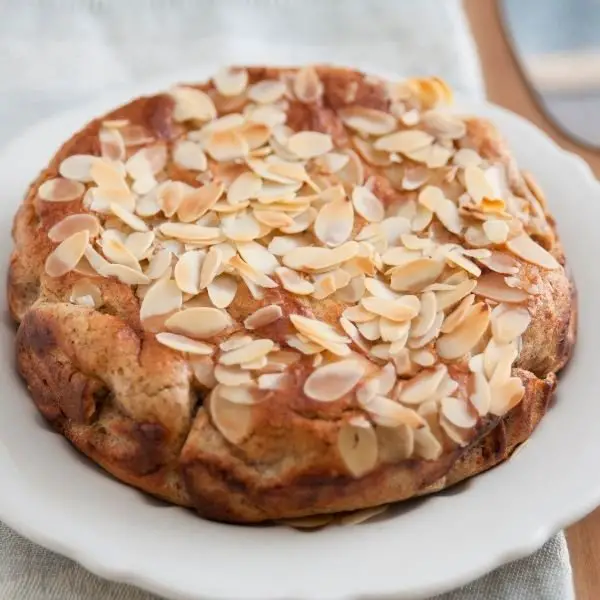Sfouf is a traditional Middle Eastern cake, which is popular in Lebanon, Syria, Palestine, and Jordan. The cake’s name ‘Sfouf’ means ‘yellow’ in Arabic, which is reflective of its color, derived from the turmeric powder used in the recipe. This cake has been a favorite dessert in the Middle East for many generations and has an interesting history behind it. In this article, we will delve into the history of Sfouf cake and explore how it has become a staple dessert in Middle Eastern cuisine.

Origins of Sfouf Cake
Sfouf cake has been around for centuries, and its origins can be traced back to the Levant region of the Middle East. The cake’s exact origin is unknown, but it is believed to have originated in Lebanon. It is said that the Phoenicians, who were renowned for their culinary skills, may have created this cake. The Phoenicians were seafarers who traveled the Mediterranean, and it is possible that they introduced Sfouf cake to other cultures.
Sfouf Cake ingredients and recipe
Sfouf cake is made from simple ingredients, such as semolina flour, sugar, vegetable oil, and turmeric powder. The recipe is straightforward, and the cake is easy to make. The semolina flour is mixed with sugar and turmeric powder, and then the vegetable oil is added. The mixture is then poured into a cake pan and baked until it is golden brown. The cake is usually served with tea or coffee.
Traditional use of Sfouf Cake
Sfouf cake is a traditional dessert that is typically served during special occasions, such as weddings, religious festivals, and family gatherings. In Lebanon, it is often served during the Muslim holiday of Eid al-Fitr, which marks the end of Ramadan. The cake is also popular during the Christian holiday of Easter. In Syria, it is a popular dessert during the month of Ramadan.
Sfouf Cake variations
While the basic recipe for Sfouf cake is the same, there are variations of the cake throughout the Middle East. In Lebanon, some people add aniseed or sesame seeds to the recipe, while in Palestine, the cake is sometimes flavored with orange blossom water. In Jordan, the cake is sometimes topped with almonds or pistachios.
The cultural significance of Sfouf Cake
Sfouf cake is more than just a dessert; it has cultural significance. It is a symbol of hospitality and generosity in Middle Eastern culture. It is also a symbol of tradition and heritage, and it is a way for families to connect with their past. Sfouf cake is often made using recipes that have been passed down from generation to generation.
Health benefits of Sfouf Cake
The turmeric used in the recipe has many health benefits, such as anti-inflammatory and antioxidant properties. It is also believed to have cancer-fighting properties. Additionally, the semolina flour used in the cake is a good source of protein and fiber.
Sfouf Cake in modern times
Sfouf cake has remained a popular dessert in Middle Eastern cuisine to this day. It is still served during special occasions and is a staple in many households. However, the recipe has evolved over time, with some people adding different ingredients to make the cake more unique.
Sfouf Cake’s popularity outside of the Middle East
Sfouf cake has gained popularity outside of the Middle East, particularly in countries with a large Middle Eastern population, such as Canada, Australia, and the United States. It is also gaining popularity in other parts of the world, as people become more interested in trying new and exotic foods.
Sfouf Cake in the age of globalization
In the age of globalization, Sfouf cake has become more accessible to people around the world. Recipes can be found online, and the ingredients can be found in specialty grocery stores. This has led to more people trying the cake and discovering the rich cultural history behind it.
Sfouf Cake and its influence on other desserts
Sfouf cake has influenced other desserts in Middle Eastern cuisine. For example, in Lebanon, there is a dessert called Maamoul, which is made with semolina flour and stuffed with dates or nuts. This dessert is similar to Sfouf cake and is believed to have been inspired by it.
Sfouf Cake and social gatherings
Sfouf cake is often served at social gatherings, such as weddings and religious festivals. It is a way for families to come together and celebrate their traditions and culture. It is also a way to connect with others and build new relationships.
Sfouf Cake in the media
Sfouf cake has been featured in various media outlets, such as food blogs and magazines. It has also been featured on cooking shows, where chefs have showcased different variations of the recipe.
FAQs
Sfouf cake is a traditional Middle Eastern cake that is popular in Lebanon, Syria, Palestine, and Jordan.
The word ‘Sfouf’ means ‘yellow’ in Arabic, which is reflective of its color, derived from the turmeric powder used in the recipe.
The ingredients used in Sfouf cake include semolina flour, sugar, vegetable oil, and turmeric powder.
Sfouf cake is a healthy dessert option as it contains no butter or eggs. The turmeric used in the recipe has anti-inflammatory and antioxidant properties, and the semolina flour used in the cake is a good source of protein and fiber.
Sfouf cake can be found in Middle Eastern baker
Conclusion
Sfouf cake is a delicious and unique dessert that has a rich cultural history behind it. Its popularity has spread beyond the Middle East, and it has become a favorite dessert among people around the world. Its simplicity and health benefits make it a great option for those looking for a healthier dessert option. Sfouf cake will continue to be an important part of Middle Eastern culture, and its legacy will live on for generations to come.
